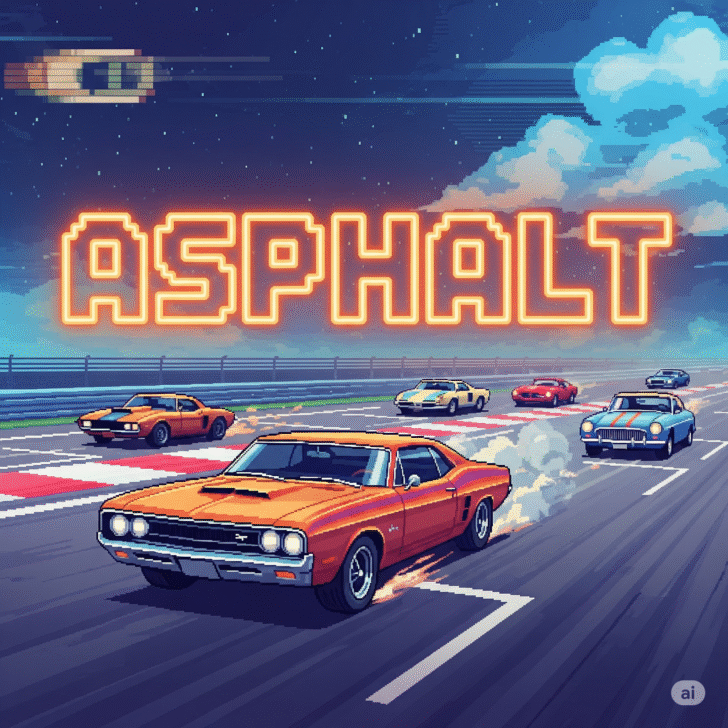Asphalt Retro
Asphalt Retro
The history of asphalt reveals its transformative journey from rudimentary 19th-century roads to vibrant modern retro aesthetics. Initially, asphalt was a practical solution for paving, prioritizing functionality over design. However, as urban landscapes evolved, so did the materials and techniques. Today, we witness a blend of traditional and contemporary styles, where asphalt not only serves as a durable surface but also infuses character into public spaces. This evolution encapsulates an intriguing shift towards embracing nostalgia while adapting to modern needs.
How to Master Asphalt Retro Gameplay: Key Controls Explained
To excel in Asphalt Retro, familiarize yourself with the key controls to enhance your gaming experience. The gameplay is designed to keep players engaged and challenged. Use the following controls for optimal performance:
- Acceleration: Press the ‘W’ key to gain speed swiftly.
- Brake: Hit the ‘S’ key to slow down and navigate sharp turns effectively.
- Steering: Utilize the ‘A’ and ‘D’ keys for precise left and right movements.
Understanding these controls will greatly enhance your ability to race with finesse in Asphalt Retro.
Exploring the Aesthetics of Asphalt Retro in Urban Design
The concept of Asphalt Retro in urban design unveils a tapestry of nostalgia intertwined with modern functionality. Cities embracing this aesthetic often showcase aged, textured surfaces that evoke a sense of history and charm. However, the juxtaposition of contemporary structures against these weathered pavements can create a cognitive dissonance, leaving observers captivated yet questioning. It’s fascinating how the embrace of Asphalt Retro fosters community interactions while challenging standard notions of beauty and utility in urban landscapes. Ultimately, this aesthetic prompts us to reconsider the foundational elements of our built environments.
The Impact of Asphalt Retro on Sustainable Infrastructure Development
The concept of Asphalt Retro plays a pivotal role in promoting sustainable infrastructure. Through innovative recycling techniques, it significantly reduces waste and resource consumption. Communities increasingly embrace these practices, recognizing that reusing materials can minimize environmental impact. Furthermore, Asphalt Retro enhances roadway longevity, thereby diminishing the frequency of repairs and maintenance. This transition not only optimizes budget allocations but also fosters a more resilient infrastructure. Ultimately, the integration of into urban planning reflects a commitment to sustainability and responsible development.
Reviving Nostalgia: How Asphalt Retro Influences Contemporary Art and Culture
The intriguing phenomenon of holds a mirror to our collective memory, merging past aesthetics with present sensibilities. Artists today harness elements from the gritty charm of vintage urban landscapes, evoking a sense of nostalgia. This trend, however, is complex. It intertwines commercialism with genuine artistic expression, creating a rich tapestry of cultural commentary. As we navigate this revival, we witness how not only shapes visual art but also enriches music, fashion, and design.
Key Influences of Asphalt Retro
- Visual Aesthetics: The color palettes and textures draw inspiration from faded murals and old signage.
- Cultural Commentary: Artists critique contemporary society by juxtaposing retro elements against modern themes.
- Fashion Trends: Vintage motifs find their way into current fashion, bridging the gap between eras.
The Role of Asphalt Retro in Shaping Traffic Patterns and City Planning
Asphalt retro is increasingly recognized for its influential role in urban design. This innovation addresses multiple challenges cities face, such as traffic congestion and sustainability. By utilizing techniques, planners can enhance road durability while possibly reducing heat absorption, which is critical in cities battling climate change. Moreover, the application of can lead to more organized traffic patterns, improving overall safety. Hence, effective use of becomes paramount in developing intelligent and adaptable urban environments.
Innovative Techniques in Asphalt Retro: Merging Tradition with Technology
In the ever-evolving field of , blending time-honored methods with modern technology proves essential. Traditional materials often face challenges such as durability and sustainability. However, techniques like cold in-place recycling encourage environmental responsibility while enhancing pavement life. This innovative approach highlights how engineers can respect established practices while embracing advancements. As develops, professionals strive for balance, often finding unexpected synergies that raise standards in road maintenance and construction.
“Innovation is not just about new technology; it’s about finding better ways to serve our communities.”
The Future Awaits
As we look ahead, the potential for continues to expand. Collaboration between traditionalists and innovators will foster improvements that benefit all. Understanding these dynamics is crucial for paving the way to a sustainable future.
Case Studies: Successful Implementations of Asphalt Retro in Global Cities
Many cities around the world have embraced technologies, leading to remarkable improvements in urban infrastructure. Notably, cities like Paris, Tokyo, and San Francisco showcase distinct successes. These implementations not only address road surface durability but also enhance sustainability. Analyzing these case studies reveals key elements that contribute to effective use:
- Innovative Techniques: Utilizing modern methodologies ensures longevity and reduces maintenance costs.
- Community Engagement: Involving local populations fosters acceptance and understanding of Asphalt Retro.
- Environmental Considerations: Prioritizing eco-friendly materials aligns with broader sustainability goals.
Overall, the journey of Asphalt Retro in these cities exemplifies how targeted approaches can yield significant benefits, encouraging others to follow suit.
Conclusion
captures a unique blend of nostalgia and modernity, inviting us to revisit the past while shaping our present. This journey down memory lane unearths the charm of classic aesthetics that still resonate today. The vibrant colors and bold designs serve as a reminder of simpler times, yet they effortlessly integrate into contemporary life. Embracing allows us to celebrate our history while embracing our individuality. In a world that often rushes forward, this movement gently nudges us to appreciate the beauty of what has come before. Ultimately, it’s not just about the style; it’s about rekindling a sense of joy and connection that transcends time.



















